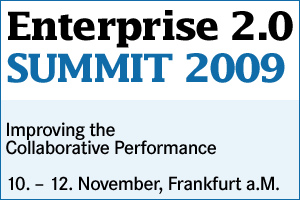Enterprise 2.0 is changing the way we work …
… and that’s why I wish Andrew McAfee’s book “Enterprise 2.0: New Collaborative Tools for your Organization’s Toughest Challenges”, all the best. Everyday corporate life can do with a change for the better …
And while it’s not about the tools, the right tools can help us “find [the] pockets of energy, highlight them, discuss them, [and] show the good stuff that emerges”. That’s what he’s telling us in this interview with McKinsey’s Roger Roberts (find the transcript of the interview at the McK Quarterly site, you may need to register there for free):
That said I feel a bit adventurous – and keen on experiments. Let’s try something: a live reading (and reviewing) of Andrew’s book tonight at 8pm CET, right here in this blog. I will add a scribblelive widget into a new post where I will collect and review my snippets and observations throughout the reading tonight. The best thing is that you can comment and participate in the reading, making it a collaborative experience. This might be done as well on Twitter, but it’s easier to aggregate all the good stuff that may emerge this way. Interesting experiment, huh?
ps. two disclosures, one – I have already read the bigger part of the book by now (you want the host to be prepared don’t you?), and two – it was given to me by Andrew’s agent at HBS Publishing knowing that I’m a blogger and would probably write about it.
Collaborating around data …
“[…] how Chatter can serve as a platform for collaboration, initially around the sales and service processes upon which Salesforce.com concentrates. As the conversation moved on, he also talked about how simply taking Twitter style feeds of itself is not enough and that that company needs to work on filtering and semantic analysis so that people are receiving the right data. This addresses the key issue of relevance around the infusion of social computing technologies into the more formalized structures of CRM (for example.)”
And on perpetual-beta mode (obvious for a SaaS-company, huh?) – he writes
“Salesforce.com is clearly in ‘thinking’ mode on this topic and will watch how customers use Chatter before making significant development investments.”
Salesforce Chatter – a “Facebook for the Enterprise”
Hmm, I think this is a smart move by Salesforce. Offering social web functionality in an established (and secure enterprise system) is probably making more inroads for Enterprise 2.0 as a concept and mindset.
Yet, we will see how much of the transformative powers remain after the “corporitization of the social web”. It’s interesting here that at least the evolving nature & perpetual-beta approach to developing ind implementing solutions seems to pull through, see the video with Salesforce’s Parker Harris which I am linking to in an instant 😉
Posted via web from frogpond’s posterous
Update: this is worth of more analysis, this whole area of established enterprise software (be it CRM, ERP, SCM, …) and the interrelations with collaborative-minded Enterprise 2.0. Will see when I get around …
Looking back at the E20SUMMIT, part 2: Wave
 So, I am in the midst of collecting and reviewing some of my learnings from the E20SUMMIT last week – let me start with Wave (after focussing on the people of the E20SUMMIT in part 1 here), and we’ll see how many parts will follow. While this Wave at conferences evaluation may seem not really focussed on Enterprise 2.0 at first it offers some insights and learnings for the ongoing discussions of adoption and organizational readiness.
So, I am in the midst of collecting and reviewing some of my learnings from the E20SUMMIT last week – let me start with Wave (after focussing on the people of the E20SUMMIT in part 1 here), and we’ll see how many parts will follow. While this Wave at conferences evaluation may seem not really focussed on Enterprise 2.0 at first it offers some insights and learnings for the ongoing discussions of adoption and organizational readiness.
What do I mean? i think that during the SUMMIT both on-site and remote participants showed deep understanding of the usage of Wave for a conference backchannel – we’ve seen mature usage, ie. nobody misinterpreted the master- or the subwaves as a forum, as twitter substitute or as “facebook wall page”. People chose the channels that were most effective and they were professional at this.
Contrast this with the one wave that was filled during the BarCamp Hamburg (search for it with tag:bchh09), the two days after the SUMMIT – here the public wave evolved into a wild hodgepodge of close to 300 blips, together with added videos and stuff – all in all, an excellent example of what happens when geeks playfully explore a new thing 😉
 I assume that the difference is the result of provisioning of some pre-filled waves and an initial stucture – much like scaffolding a wiki this prepared and leveled the playing field, made it easier for new wavers to enter the E20SUMMIT wave space, find their way around and contribute in a meaningful way. That said, it’s probably an insight for our expectations regarding our employee’s readiness and competencies in using innovative collaboration infrastructures – even geeks on the cutting edge of the social web (like BarCampers typically are) aren’t grokking and mastering the new collaboration approaches easily. Scaffolding seems to be an essential element of enabling them (and their much less geeky colleagues). As such it’s a part of the “implementation effort” (in quoting signs because as we’ve learned at the SUMMIT implementation means different things to different people), I collect and systematize under the notions of “kennen-können-wollen-sollen”, ie. “know about it – master it – want it – be obliged (and ordered to)”. Scaffolding supports all four areas, and consequentially enabled the sustainable growth of the E20SUMMIT waves …
I assume that the difference is the result of provisioning of some pre-filled waves and an initial stucture – much like scaffolding a wiki this prepared and leveled the playing field, made it easier for new wavers to enter the E20SUMMIT wave space, find their way around and contribute in a meaningful way. That said, it’s probably an insight for our expectations regarding our employee’s readiness and competencies in using innovative collaboration infrastructures – even geeks on the cutting edge of the social web (like BarCampers typically are) aren’t grokking and mastering the new collaboration approaches easily. Scaffolding seems to be an essential element of enabling them (and their much less geeky colleagues). As such it’s a part of the “implementation effort” (in quoting signs because as we’ve learned at the SUMMIT implementation means different things to different people), I collect and systematize under the notions of “kennen-können-wollen-sollen”, ie. “know about it – master it – want it – be obliged (and ordered to)”. Scaffolding supports all four areas, and consequentially enabled the sustainable growth of the E20SUMMIT waves …
Mid-stage evaluation of live Waving at E20SUMMIT
 I think our little experiment turned up some pretty good conversations and real-time collaboration success stories. Not all of the prepared waves got filled extensively, but that’s ok. Not all of the attendees are bringing their laptops to a conference, and among those that have, not all are on Wave. So I am pretty satisfied and think that this is an excellent add-on and complements the “behind the scenes” doumentation in the wiki, the live-blogging and -tweeting around the E20SUMMIT (and of course the provisioning of the presentation slides).
I think our little experiment turned up some pretty good conversations and real-time collaboration success stories. Not all of the prepared waves got filled extensively, but that’s ok. Not all of the attendees are bringing their laptops to a conference, and among those that have, not all are on Wave. So I am pretty satisfied and think that this is an excellent add-on and complements the “behind the scenes” doumentation in the wiki, the live-blogging and -tweeting around the E20SUMMIT (and of course the provisioning of the presentation slides).
Live-Waving the Enterprise 2.0 masterclass
Just a proof of concept – but it’s promising, if only because it allows Non-Wavers to get a peek into the backchannel to whet the non-Wavers appetite 😉
No I am joking but I am totally impressed by Google Wave’s fast-increasing abilities, well rather of the business ecosystem of gadgets, robots and plugins.